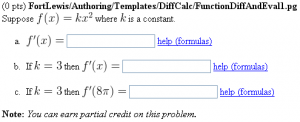Difference between revisions of "DifferentiateFunction1"
Paultpearson (talk | contribs) m |
|||
| Line 194: | Line 194: | ||
[[Category:Top]] |
[[Category:Top]] |
||
| − | [[Category: |
+ | [[Category:Sample Problems]] |
| + | [[Category:Subject Area Templates]] |
||
Revision as of 16:37, 3 January 2012
Differentiating and Evaluating a Function
This PG code shows how to create a function using MathObjects, differentiate it, and evaluate it.
- Download file: File:DifferentiateFunction1.txt (change the file extension from txt to pg when you save it)
- File location in NPL:
FortLewis/Authoring/Templates/DiffCalc/DifferentiateFunction1.pg
| PG problem file | Explanation |
|---|---|
|
Problem tagging: |
|
DOCUMENT(); loadMacros( "PGstandard.pl", "MathObjects.pl", "AnswerFormatHelp.pl", "unionLists.pl", ); TEXT(beginproblem()); |
Initialization:
We load |
Context("Numeric")->variables->add(k=>"Real");
Context()->flags->set(
reduceConstants=>0, # no decimals
reduceConstantFunctions=>1, # combine 4+5*2?
formatStudentAnswer=>'parsed', # no decimals
);
$a = random(6,9,1);
$k = random(3,5,1);
$f = Formula("k x^2");
$fx = $f->D('x');
@answer = ();
$answer[0] = $fx;
$answer[1] = $fx->substitute(k=>$k);
$answer[2] = $fx->substitute(x=>$a*pi,k=>$k);
|
Setup:
The partial differentiation operator is
The main difference between
$k into the Formula $f returns a Formula $k x, if we had used the eval method $answer[1] = $fx->eval(k=>$k); instead of the substitute method, we would get errors because $k x is a Formula, not a Real. Note: You cannot use eval or substitute to perform function composition, i.e., you can only plug in numbers, not formulas.
When the answer is a constant, we can use either the eval method, in which case the answer would be a Real, or the substitute method, in which case the answer would be a constant Formula. If you use the eval method, For more details, see eval versus substitute, formatting correct answers, and constants in problems. |
Context()->texStrings;
BEGIN_TEXT
Suppose \( f(x) = $f \) where \( k \) is a
constant.
\{ BeginList("OL",type=>"a") \}
$ITEM \( f'(x) = \)
\{ ans_rule(20) \}
\{ AnswerFormatHelp("formulas") \}
$ITEMSEP
$ITEM If \( k = $k \) then \( f'(x) = \)
\{ ans_rule(20) \}
\{ AnswerFormatHelp("formulas") \}
$ITEMSEP
$ITEM If \( k = $k \) then \( f'($a\pi) = \)
\{ ans_rule(20) \}
\{ AnswerFormatHelp("formulas") \}
\{ EndList("OL") \}
END_TEXT
Context()->normalStrings;
|
Main Text:
We use an ordered list to display the three parts to this question. The |
$showPartialCorrectAnswers = 1;
foreach my $i (0..2) {
ANS( $answer[$i]->cmp() );
}
|
Answer Evaluation: |
Context()->texStrings;
BEGIN_SOLUTION
${PAR}SOLUTION:${PAR}
Solution explanation goes here.
END_SOLUTION
Context()->normalStrings;
COMMENT("MathObject version.");
ENDDOCUMENT();
|
Solution: |
